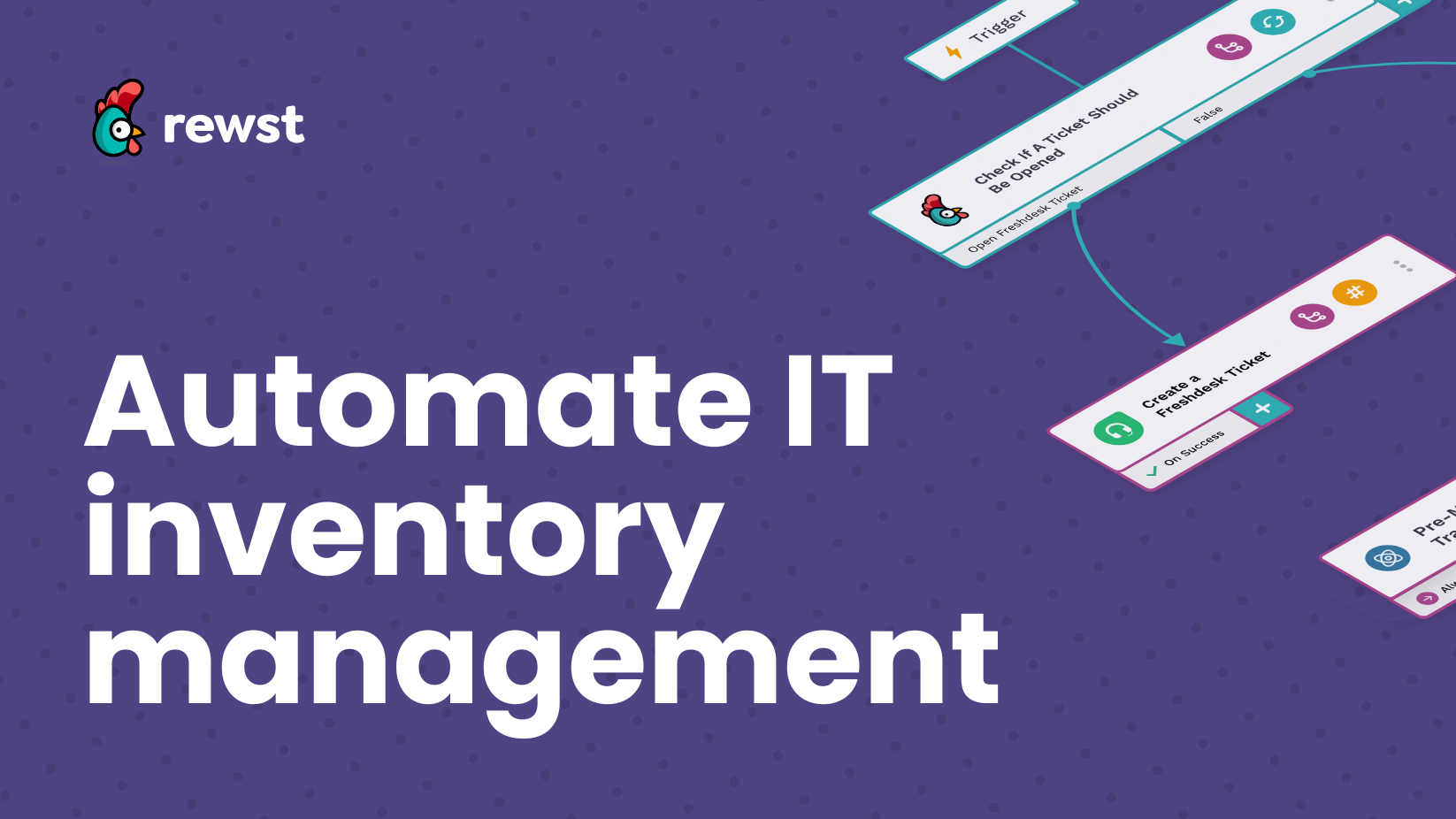Maximize your MSP’s efficiency with these 3 principles of automation
Discover the key principles of automation for MSP success in 2024. Learn how to streamline processes and master automation with Rewst.

Imagine this— your MSP is fired up and ready to embrace the exciting world of automation. You and your team are starting to build workflows with Rewst. You are learning the basics of automation, using essential tools for success, and taking Cluck U courses. Now, your next step is to ensure your automation journey is not just successful but transformative.
If that sounds like your present situation, let’s explore three fundamental principles of automation to master straight from the expert, Eddie Chow, Training and Enablement Manager at Rewst.
1. First principle of automation: You cannot automate a process that doesn’t exist - Aharon’s Law
Aharon’s Law is like the architect’s blueprint before construction begins—it reminds us to define processes clearly before automating them. Imagine building a house without knowing where to start or what the result should look like. To automate effectively, you need a clear starting point, a defined goal, and a way to measure success.

When diving into automation, remember these fundamental rules:
- Focus on solving real problems.
- Look for tasks that are time-consuming, repetitive, error-prone, or highly demanded by customers.
- Follow the 80/20 rule to prioritize the most impactful processes. The 80/20 rule states that roughly 80% of consequences come from 20% of causes for many outcomes.
Furthermore, ensure your automation is technically feasible and has a clear success metric. Make sure to consider maintenance when choosing tasks. Opt for functions that your team can easily maintain over time.
- Applying the following software development principles to automation is crucial:
- Keep it simple—complex solutions only lead to more headaches.
- Ensure your automations are easy to maintain and adapt to changing needs.
- Design components that technicians can re-use across different automations to save time and maintain consistency.
- Always anticipate errors and log them for review to keep your processes running smoothly.
Consider who stands to benefit from automation. Technicians can automate repetitive tasks, making their work more efficient and error-free. Customers enjoy better experiences and business results, like faster service and accurate information. Back-office operations can streamline tasks such as billing and resource allocation.
By following these principles and considering who will benefit from automation, we can ensure our efforts are targeted, effective, and aligned with our business goals. It’s like building a well-oiled machine that keeps everything running smoothly.
2. Second principle of automation: Automation is forgettable
Imagine automation as your silent partner in success—so seamlessly integrated into your daily grind that you barely notice it, much like the effortless act of breathing or the reflexive blink of an eye. The real value of automation lies in its ability to save time, reduce errors, improve decision-making, and create a more enjoyable work experience. By delegating mundane tasks to automation, you unlock a universe of scalability for your business. This shift empowers your team to concentrate on strategic growth levers and paves the way for personal career advancement.
But here’s a word to the wise: moderation is key. Diving headfirst into automating everything—be it the entire user onboarding process or swapping out a critical tool—might backfire, leaving you in a lurch. The smarter play? Enhance the harmony among your existing tools and pick well-documented, clearly defined tasks for automation. And remember, “low code” doesn’t have to mean “bad code.”

Think of your automation team as a trio of time travelers: you, your past self, and your future self. As you embark on this journey, consider how each version of you interacts with your creations. Draw from past experiences and lay down a path your future self can easily navigate. Naming your variables, commenting on your workflow actions and Jinja statements, and documenting your workflows are essential practices to ensure the longevity and effectiveness of your automations.
While automation should be your silent partner, you still want to ensure leadership knows that partner exists. According to Eddie’s training, it’s imperative that workflow builders highlight the benefits of automation to management in a memorable way. This reporting ensures that automations are adequately credited and remembered. Providing clear evidence of improvements, such as time savings or reduced errors, effectively showcases the positive impact of their automation efforts.
Leveraging Rewst features such as templates, scripts, org variables, triggers, and more can make your automations robust and reliable. By following these tips and best practices, you can ensure that your automation efforts are successful and sustainable in the long term.
3. Third principle of automation: Start with Small, Simple, Time-Consuming, High Frequency
Embarking on the automation journey within your organization is not just about leveraging technology; it’s about unlocking a new realm of efficiency and scalability. Imagine a world where repetitive tasks no longer consume your team’s valuable time, all processes are streamlined, and adaptability is not just a goal but a reality. This vision is achievable, and the pathway there is marked by strategic principles and practices that ensure your automation initiatives’ success and exponential growth.
Start Small, Think Big
Kick off your automation adventure with tasks that, although small, pack a punch in terms of value. It’s like planting seeds that grow into a lush garden of efficiency and productivity. These initial wins are not just about proving the concept but about learning what works and setting a foundation for scalable growth.
Embrace the DRY Philosophy
“Don’t Repeat Yourself” (DRY) might sound simple, but its implications are profound. By eliminating redundancy in your automations, you ensure that updates are a breeze, consistency is a given, and your systems are as sleek as they are efficient. It’s about doing more with less and ensuring every change is a step forward.
Make it ETC - Easy to Configure
The beauty of automation lies in its flexibility and the ease with which it can adapt to changing needs. By designing with adaptability in mind—making systems easy to tweak and configure—, you empower everyone in your organization, technical or not, to drive change and innovation.
Defensive Automation: Your Safety Net
Just as a tightrope walker uses a net, defensive automation safeguards your processes. Anticipating potential pitfalls and errors allows your systems to handle the unexpected gracefully, ensuring reliability and building trust in your automated processes.
Steer Clear of the Monolith
In a world that celebrates the grand and the majestic, here’s a counterintuitive nugget of wisdom: avoid monolithic automation—instead, champion modularity and abstraction. Break down complex tasks into digestible, manageable chunks that can be easily understood, maintained, and improved. This approach simplifies your automation efforts and turns them into a scalable, flexible mosaic of efficiency.
Build, Reuse, Scale
As you embark on this journey, remember that every small task automated today can be a building block for tomorrow’s innovations. By creating a library of reusable workflows, you’re not just coding; you’re composing a symphony of efficiency where each note plays a vital role. This approach streamlines your efforts and sets a scalable blueprint for the future.
The Path to Mastery
Remember, as in all things, mastery in automation comes with practice and persistence. Celebrate your successes, learn from every challenge, and continuously refine your approach. As you do, you’ll unlock the full potential of automation within your organization and pave the way for a future where your team’s creativity and strategic insight, not their capacity for repetitive work, define your success.
In sum, by starting small, adhering to foundational principles, and embracing a mindset of continuous improvement, you can transform the landscape of your operations and unlock a new horizon of possibilities. Welcome to the future of work, where automation is your ally, efficiency is the norm, and the innovation potential is limitless.
Embracing the Future of Automation
In 2024, MSPs are moving beyond just implementing automation—they’re mastering it. They’re streamlining processes, improving efficiency, and enhancing the customer experience while saving time and resources. As predicted by Aharon, more MSPs are investing in continuous learning, with certifications from Cluck University becoming a badge of honor.
With Rewst’s innovative approach and dedication to empowering MSPs, the automation journey is not just about keeping up with the competition; it’s about setting the stage for continued success in the ever-evolving landscape of MSP services. So, as you embark on your automation journey, remember these principles, embrace the future of automation, and watch your business soar to new heights.
Latest Blog Posts
Subscribe to Our Blog
Stay up to date with the latest on our platform, automation, events and news.
We're committed to your privacy. Rewst uses the information you provide to us to contact you about our relevant content, products, and services. You may unsubscribe from these communications at any time.









